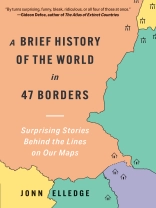Every border tells a surprising story in this uncommonly enlightening history that will change the way you understand the world
“A novel and fascinating perspective on world history.”—Bill Bryson, author of A Short History of Nearly Everything
Many lines on the map are worth far more than a thousand words, going well beyond merely marking divisions between nations. In this eye-opening investigation into the most remarkable points on the map, a single boundary might, upon closer inspection, reveal eons of history—from epic tales of conquest, treaties, and alliances to intimate, all-too-human stories of love, greed, and folly. Sometimes rooted in physical geography, sometimes entirely arbitrary, none of the lines we know today were inevitable, and all might have looked quite different if not for the intricate interplay of chance and ambition.
By listening to the stories these borders have to tell, we can learn how political identities are shaped, why the world’s boundaries look the way they do—and what they tell us about our world and ourselves. From the very first maps in Egypt to the Roman attempts to define the boundaries of civilization, from the profound shift in meaning of the Mason–Dixon line to the secret British-French agreement to carve up the Ottoman Empire during the First World War, and from the dark consequences of Detroit’s city limits to the intriguing reason why landlocked Bolivia still maintains a navy, this is a singular look at human history—told through its most spellbinding border stories.
قائمة المحتويات
Introduction
PART ONE: HISTORIES
The Unification of Upper and Lower Egypt
The Great Wall of China and the Border as Unifier
Why is Europe Not a Peninsula in Asia?
The Roman Limes and the Power of the Periphery
The Legacies of Charlemagne
The Borders of Great Britain
Of Feudalism, Marquises, Margraves, and Marcher Lords
The Open Borders Policies of Genghis Khan
Spain and Portugal Carve up the World
Holy, Roman and an Empire
Britain, Ireland, and the Invention of Cartographic Colonialism
The Much Misunderstood Mason–Dixon Line
The Local Government Reforms of Emperor Napoleon I
The American Invasion of Mexico
The Schleswig-Holstein Business
“. . . Where No White Man Ever Trod”
The Sudan–Uganda Border Commission, 1913
European Nationalism and the United States of Greater Austria
Britain and France Carve up the Middle East
The Partition of Ulster, 1916–22
The Partition of India, 1947
The Iron Curtain and the Division of Berlin, 1945–90
PART TWO: LEGACIES
Koenigsberg/Kaliningrad, Eastern Germany/Western Russia
The Strange Case of Bir Tawil
The Dangers of Gardening in the Korean DMZ
China’s Nine-dash Line and Its Discontents
The Uncertain Borders Between Israel and Palestine
The Siamese Twin Towns of Baarle-Hertog and Baarle-Nassau
The US–Canada border, and the Trouble with Straight Lines
Some Places Which Aren’t Switzerland
Some Notes on Microstates
City Limits
The Curse of Suburbia and the Borders of Detroit
Washington, DC and the Square Between the States
Borders from a Land Down Under
Some Accidental Invasions
Costa Rica, Nicaragua and the “Google Maps War”
The Mapmaker’s Dilemma
PART THREE: EXTERNALITIES
A Brief History of the Prime Meridian
Some Notes on Time Zones
A Brief History of the International Date Line
Of Maritime Boundaries and the Law of the Sea
Some Notes on Landlocked Countries
How the World Froze Territorial Claims in Antarctica
The Other, Bigger, More Musical Europe
Boundaries in the Air
The Final Frontier
Conclusion: The End of the Line
Sources
Acknowledgements
Index
عن المؤلف
Jonn Elledge’s previous books include The Compendium of (Not Quite) Everything and Conspiracy: A History of Boll*cks Theories, and How Not to Fall for Them. At the New Statesman he created and ran its urbanism-focused City Metric site, spending six happy years writing about cities, maps, and borders. He lives in London.












